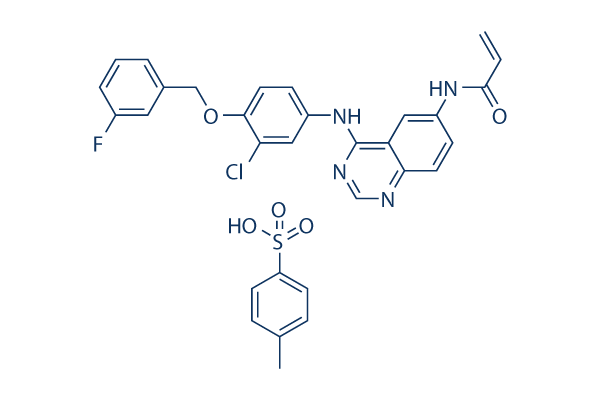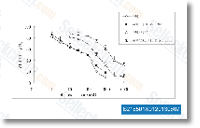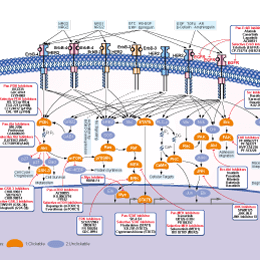
- 阻害剤
- 研究分野別
- PI3K/Akt/mTOR
- Epigenetics
- Methylation
- Immunology & Inflammation
- Protein Tyrosine Kinase
- Angiogenesis
- Apoptosis
- Autophagy
- ER stress & UPR
- JAK/STAT
- MAPK
- Cytoskeletal Signaling
- Cell Cycle
- TGF-beta/Smad
- 化合物ライブラリー
- Popular Compound Libraries
- Customize Library
- Clinical and FDA-approved Related
- Bioactive Compound Libraries
- Inhibitor Related
- Natural Product Related
- Metabolism Related
- Cell Death Related
- By Signaling Pathway
- By Disease
- Anti-infection and Antiviral Related
- Neuronal and Immunology Related
- Fragment and Covalent Related
- FDA-approved Drug Library
- FDA-approved & Passed Phase I Drug Library
- Preclinical/Clinical Compound Library
- Bioactive Compound Library-I
- Bioactive Compound Library-II
- Kinase Inhibitor Library
- Express-Pick Library
- Natural Product Library
- Human Endogenous Metabolite Compound Library
- Alkaloid Compound LibraryNew
- Angiogenesis Related compound Library
- Anti-Aging Compound Library
- Anti-alzheimer Disease Compound Library
- Antibiotics compound Library
- Anti-cancer Compound Library
- Anti-cancer Compound Library-Ⅱ
- Anti-cancer Metabolism Compound Library
- Anti-Cardiovascular Disease Compound Library
- Anti-diabetic Compound Library
- Anti-infection Compound Library
- Antioxidant Compound Library
- Anti-parasitic Compound Library
- Antiviral Compound Library
- Apoptosis Compound Library
- Autophagy Compound Library
- Calcium Channel Blocker LibraryNew
- Cambridge Cancer Compound Library
- Carbohydrate Metabolism Compound LibraryNew
- Cell Cycle compound library
- CNS-Penetrant Compound Library
- Covalent Inhibitor Library
- Cytokine Inhibitor LibraryNew
- Cytoskeletal Signaling Pathway Compound Library
- DNA Damage/DNA Repair compound Library
- Drug-like Compound Library
- Endoplasmic Reticulum Stress Compound Library
- Epigenetics Compound Library
- Exosome Secretion Related Compound LibraryNew
- FDA-approved Anticancer Drug LibraryNew
- Ferroptosis Compound Library
- Flavonoid Compound Library
- Fragment Library
- Glutamine Metabolism Compound Library
- Glycolysis Compound Library
- GPCR Compound Library
- Gut Microbial Metabolite Library
- HIF-1 Signaling Pathway Compound Library
- Highly Selective Inhibitor Library
- Histone modification compound library
- HTS Library for Drug Discovery
- Human Hormone Related Compound LibraryNew
- Human Transcription Factor Compound LibraryNew
- Immunology/Inflammation Compound Library
- Inhibitor Library
- Ion Channel Ligand Library
- JAK/STAT compound library
- Lipid Metabolism Compound LibraryNew
- Macrocyclic Compound Library
- MAPK Inhibitor Library
- Medicine Food Homology Compound Library
- Metabolism Compound Library
- Methylation Compound Library
- Mouse Metabolite Compound LibraryNew
- Natural Organic Compound Library
- Neuronal Signaling Compound Library
- NF-κB Signaling Compound Library
- Nucleoside Analogue Library
- Obesity Compound Library
- Oxidative Stress Compound LibraryNew
- Phenotypic Screening Library
- PI3K/Akt Inhibitor Library
- Protease Inhibitor Library
- Protein-protein Interaction Inhibitor Library
- Pyroptosis Compound Library
- Small Molecule Immuno-Oncology Compound Library
- Mitochondria-Targeted Compound LibraryNew
- Stem Cell Differentiation Compound LibraryNew
- Stem Cell Signaling Compound Library
- Natural Phenol Compound LibraryNew
- Natural Terpenoid Compound LibraryNew
- TGF-beta/Smad compound library
- Traditional Chinese Medicine Library
- Tyrosine Kinase Inhibitor Library
- Ubiquitination Compound Library
-
Cherry Picking
You can personalize your library with chemicals from within Selleck's inventory. Build the right library for your research endeavors by choosing from compounds in all of our available libraries.
Please contact us at info@selleck.co.jp to customize your library.
You could select:
- FDA-approved Drug Library
- FDA-approved & Passed Phase I Drug Library
- Preclinical/Clinical Compound Library
- Bioactive Compound Library-I
- Bioactive Compound Library-II
- Kinase Inhibitor Library
- Express-Pick Library
- Natural Product Library
- Human Endogenous Metabolite Compound Library
- Covalent Inhibitor Library
- FDA-approved Anticancer Drug LibraryNew
- Highly Selective Inhibitor Library
- HTS Library for Drug Discovery
- Metabolism Compound Library
- 抗体
- 新製品
- お問い合わせ
Allitinib tosylate
別名:AST-1306 TsOH, AST-6
Allitinib (AST-1306, AST-6) is a novel irreversible inhibitor of EGFR and ErbB2 with IC50 of 0.5 nM and 3 nM, also effective in mutation EGFR T790M/L858R, more potent to ErbB2-overexpressing cells, 3000-fold selective for ErbB family than other kinases.

CAS No. 1050500-29-2
文献中Selleckの製品使用例(16)
カスタマーフィードバック1例
製品安全説明書
現在のバッチを見る:
S218501
DMSO]
124 mg/mL]
false]
Water]
Insoluble]
false]
Ethanol]
Insoluble]
false
純度:
99.93%
99.93
Allitinib tosylate関連製品
シグナル伝達経路
EGFR阻害剤の選択性比較
| 阻害剤 | Citation | EGFR/ErbB1 | HER2/ErbB2 | ErbB3 | ErbB4 | mutant EGFR | その他 |
|---|---|---|---|---|---|---|---|
| Saracatinib (AZD0530) | 299 | c-Src,c-YES,LCK | |||||
| Canertinib (CI-1033) | 48 | ||||||
| AG-490 | 132 | JAK2 (V617F) | |||||
| CP-724714 | 108 | ||||||
| WZ4002 | 34 | ||||||
| Sapitinib (AZD8931) | 48 | ||||||
| CUDC-101 | 23 | HDAC,HDAC1,HDAC6 | |||||
| AG-1478 | 97 |
もっと見る
1. "+" indicates inhibitory effect. Increased inhibition is marked by a higher "+" designation. 2. "✔" indicates inhibitory effect, but without specific value.
Cell Data
| Cell Lines | Assay Type | Concentration | Incubation Time | 活性情報 | PMID |
|---|---|---|---|---|---|
| NCI-H1975 cells | Proliferation assay | 72 h | Antiproliferative activity against human NCI-H1975 cells over-expressing EGFR mutant gene after 72 hrs by SRB assay, IC50=0.7 μM | 22227214 | |
| A431 cells | Proliferation assay | 72 h | Antiproliferative activity against human A431 cells over-expressing EGFR gene after 72 hrs by SRB assay, IC50=0.2 μM | 22227214 | |
| A549 cells | Proliferation assay | 72 h | Antiproliferative activity against human A549 cells over-expressing EGFR gene after 72 hrs by SRB assay, IC50=6.8 μM | 22227214 | |
| 他の多くの細胞株試験データをご覧になる場合はこちらをクリックして下さい | |||||
生物活性
| 製品説明 | Allitinib (AST-1306, AST-6) is a novel irreversible inhibitor of EGFR and ErbB2 with IC50 of 0.5 nM and 3 nM, also effective in mutation EGFR T790M/L858R, more potent to ErbB2-overexpressing cells, 3000-fold selective for ErbB family than other kinases. | ||||||||
|---|---|---|---|---|---|---|---|---|---|
| Targets |
|
| In Vitro | ||||
| In vitro | AST-1306 also ErB2 and EGFR T790M/L858R double mutant. AST-1306 is approximately 500-fold more potent than lapatinib and more than 3000-fold selective for ErbB family kinases over other kinase families including PDGFR, KDR and c-Met. AST-1306 might covalently bind to specific amino acid residues of EGFR and ErbB2. AST-1306 acts in a concentration dependent manner to significantly inhibit the growth of HIH3T3-EGFR T790M/L858R cells. AST-1306 effectively suppresses EGFR phosphorylation in HIH3T3-EGFR T790M/L858R cells. Moreover, AST-1306 blocks the growth of NCI-H1975 cells that harbor the EGFR T790M/L858R mutation in a concentration-dependent manner. AST-1306 blocks phosphorylation of EGFR and downstream pathways as well. In addition, AST-1306 dose-dependently and markedly inhibits EGF-induced EGFR phosphorylation in A549 cells. AST-1306 inhibits the phosphorylation of EGFR and ErbB2, and downstream signaling in human cancer cells including A549 cells, Calu-3 cells and SK-OV-3 cells. [1] | |||
|---|---|---|---|---|
| Kinase Assay | Tyrosine kinase assays | |||
| The tyrosine kinase activities are determined in 96-well ELISA plates precoated with 20 μg/mL Poly (Glu,Tyr)4:1. First, 80 μL of 5 μM ATP solution diluted in kinase reaction buffer (50 mM HEPES pH 7.4, 20 mM MgCl2, 0.1 mM MnCl2, 0.2 mM Na3VO4, 1 mM DTT) is added to each well. Various concentrations of AST-1306 diluted in 10 μL of 1% DMSO (v/v) are then added to each reaction well, with 1% DMSO (v/v) used as the negative control. Subsequently, the kinase reaction is initiated by the addition of purified tyrosine kinase proteins diluted in 10 μL of kinase reaction buffer solution. Experiments at each concentration are performed in duplicate. After incubation for 60 min at 37 °C, the plate is washed three times with phosphate buffered saline (PBS) containing 0.1% Tween 20 (T-PBS). Next, 100 μL anti-phosphotyrosine antibody (PY99, 1:500 dilution) diluted in T-PBS containing 5 mg/mL BSA is added. After 30 min incubation at 37 °C, the plate is washed three times as before. Horseradish peroxidase-conjugated goat anti-mouse IgG (100 μL) diluted 1:2000 in T-PBS containing 5 mg/mL BSA is added. The plate is reincubated at 37 °C for 30 min, and then washed with PBS. Finally, 100 μL of a solution containing 0.03 % H2O2 and 2 mg/mL o-phenylenediamine in 0.1 M citrate buffer, pH 5.5, is added and samples are incubated at room temperature until color emerged. The reaction is terminated by the addition of 50 μL of 2 M H2SO4, and the plate is read using a multi-well spectrophotometer at 490 nm. The inhibition rate (%) is calculated using the following equation: [1-(A490 treated /A490 control)] ×100%. IC50 values are determined from the results of at least three independent tests and calculated by Logit method. | ||||
| 細胞実験 | 細胞株 | Calu-3 and A-549 cell lines | ||
| 濃度 | 0.001-1 μM | |||
| 反応時間 | 72 hours | |||
| 実験の流れ | Cell (including Calu-3, A-549 cell line et al.) proliferation is evaluated using the SRB (Sulforhodamine B) assay. Briefly, cells are seeded into 96-well plates and grown for 24 hours. The cells are then treated with increasing concentrations of AST-1306 and grown for a further 72 hours. The medium remains unchanged until the completion of the experiment. The cells are then fixed with 10% precooled trichloroacetic acid (TCA) for 1 hour at 4 °C and stained for 15 min at room temperature with 100 μL of 4 mg/mL SRB solution in 1% acetic acid. The SRB is then removed, and the cells are quickly rinsed five times with 1% acetic acid. After cells are air-dried, protein-bound dye is dissolved in 150 μL of 10 mM Tris base for 5 min and measured at 515 nm using a multiwell spectrophotometer. The inhibition rate on cell proliferation is calculated as (1 - A515 treated/A515 control) × 100%. The IC50 value is obtained by the Logit method and is determined from the results of at least 3 independent tests. | |||
| In Vivo | ||
| In Vivo | Twice daily oral administration of AST-1306 gives rise to a dramatic prevention of tumor growth in SK-OV-3 and Calu-3 xenograft models. In SK-OV-3 models, tumors nearly disappears after treatment with AST-1306 for 7 days. In contrast, AST-1306 only slightly inhibits the growth of tumor in HO-8910 and A549 xenograft models. Therefore, the antitumor efficacy of AST-1306 is greater in ErbB2-overexpressing tumor models than in models expressing low levels of ErbB2. AST-1306 is well tolerated. Lapatinib displays antitumor activity in these ErbB2-overexpressing tumor models, but AST-1306 is more efficacious than lapatinib in the SK-OV-3 xenograft tumor model when given at the same dose and schedule. In addition, oral administration of AST-1306 twice daily for 3 weeks dramatically suppresses the growth of tumor in the FVB-2/Nneu models. After treatment for 11 days, tumors almost completely disappears. The body weights of the mice reduces by less than 20% during treatment. [1] | |
|---|---|---|
| 動物実験 | 動物モデル | Nude mice bearing SK-OV-3 xenograft tumors and SK-OV-3FVB-2/Nneu transgenic mouse |
| 投与量 | 25 mg/kg, 50 mg/kg and 100 mg/kg | |
| 投与経路 | p.o., twice daily | |
化学情報
| 分子量 | 621.08 | 化学式 | C24H18ClFN4O2,C7H8O3S |
| CAS No. | 1050500-29-2 | SDF | Download Allitinib tosylate SDFをダウンロードする |
| Smiles | CC1=CC=C(C=C1)S(=O)(=O)O.C=CC(=O)NC1=CC2=C(C=C1)N=CN=C2NC3=CC(=C(C=C3)OCC4=CC(=CC=C4)F)Cl | ||
| 保管 | |||
|
In vitro |
DMSO : 124 mg/mL ( (199.65 mM); 吸湿したDMSOは溶解度を減少させます。新しいDMSOをご使用ください。) Water : Insoluble Ethanol : Insoluble |
モル濃度計算器 |
|
in vivo Add solvents to the product individually and in order. |
投与溶液組成計算機 | ||||
| Homogeneous suspension |
0.5% hydroxyethyl cellulose
|
10.0mg/ml (16.10mM) | Taking the 1 mL working solution as an example, take 10 mg of this product, add it to 1 ml of 0.5% hydroxyethyl cellulose clear solution, and mix evenly to form a uniform suspension. The mixed solution should be used immediately for optimal results. | ||
実験計算
投与溶液組成計算機(クリア溶液)
ステップ1:実験データを入力してください。(実験操作によるロスを考慮し、動物数を1匹分多くして計算・調製することを推奨します)
mg/kg
g
μL
匹
ステップ2:投与溶媒の組成を入力してください。(ロット毎に適した溶解組成が異なる場合があります。詳細については弊社までお問い合わせください)
% DMSO
%
% Tween 80
% ddH2O
%DMSO
%
計算結果:
投与溶媒濃度: mg/ml;
DMSOストック溶液調製方法: mg 試薬を μL DMSOに溶解する(濃度 mg/mL, 注:濃度が当該ロットのDMSO溶解度を超える場合はご連絡ください。 )
投与溶媒調製方法:Take μL DMSOストック溶液に μL PEG300,を加え、完全溶解後μL Tween 80,を加えて完全溶解させた後 μL ddH2O,を加え完全に溶解させます。
投与溶媒調製方法:μL DMSOストック溶液に μL Corn oil,を加え、完全溶解。
注意:1.ストック溶液に沈殿、混濁などがないことをご確認ください;
2.順番通りに溶剤を加えてください。次のステップに進む前に溶液に沈殿、混濁などがないことを確認してから加えてください。ボルテックス、ソニケーション、水浴加熱など物理的な方法で溶解を早めることは可能です。
技術サポート
ストックの作り方、阻害剤の保管方法、細胞実験や動物実験の際に注意すべき点など、製品を取扱う時に問い合わせが多かった質問に対しては取扱説明書でお答えしています。
他に質問がある場合は、お気軽にお問い合わせください。
* 必須
Tags: Allitinib tosylateを買う | Allitinib tosylate ic50 | Allitinib tosylate供給者 | Allitinib tosylateを購入する | Allitinib tosylate費用 | Allitinib tosylate生産者 | オーダーAllitinib tosylate | Allitinib tosylate化学構造 | Allitinib tosylate分子量 | Allitinib tosylate代理店


